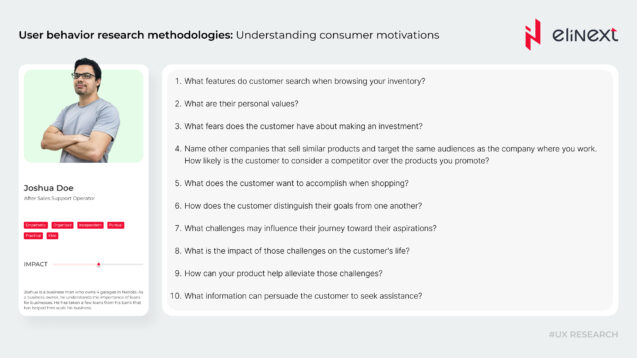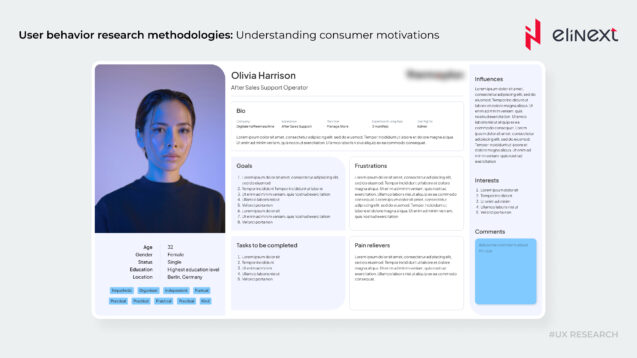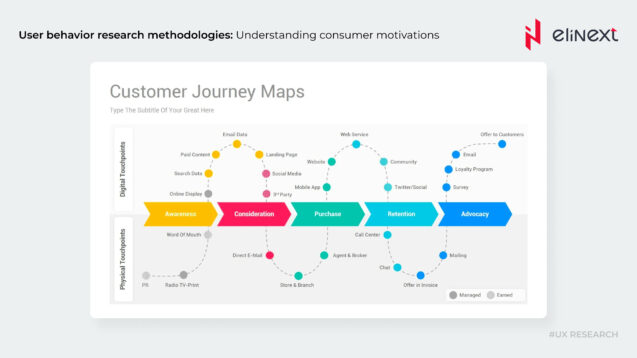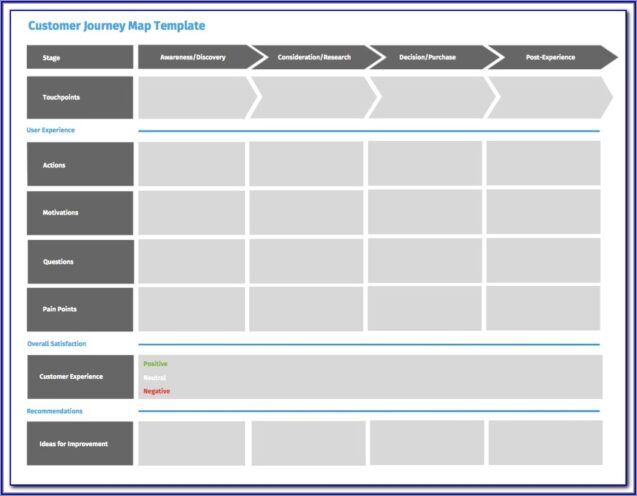What Methods Are Used To Conduct User Experience (UX) Research?
There are several methods for conducting UX research, including surveys, observations, testing, and data analysis. Each of these methods has its advantages and disadvantages, and the choice of method depends on the specific task and goals of the research.
Surveys
Let’s begin with one of the most popular methods: surveys. Surveys allow gathering information from a large number of users and quickly obtaining results. However, surveys can be subjective and may not always accurately reflect actual user behavior.
UX surveys are conducted to gather users’ opinions about a product or service. Typically, surveys are conducted in the form of questionnaires that users fill out themselves.
To conduct a UX survey, it is necessary to develop questions that reflect the key aspects of the user experience. Questions can be open-ended, allowing users to answer them in their own words, or closed-ended, requiring them to choose one of the answer options you provide.
After the questions are developed, respondents for the survey need to be selected. These can be either real users of the product or service or specially hired individuals to conduct the survey.
Then the survey itself needs to be conducted, data collected, and analyzed. Data analysis will help you identify the strengths and weaknesses of the product or service and enable you to make data-driven decisions about its improvement.
Example survey questions:
Observations
Observations are another method that can be used to study the user experience. Observations can be conducted both in real life and in laboratory conditions. This method allows for seeing how users interact with the product and identifying interface problems.
Testing
Testing is another important method of UX research. Testing can be conducted using both real users and virtual users. Testing allows for verifying hypotheses and assumptions about the user experience, as well as identifying problems that users may encounter.
User Personas
In the previous article, we discussed the successful use of the User Personas method in development. More information can be found here.
Customer Journey Map Cheat Sheet: Practical Roadmap to Success
A customer journey map (CJM) is a visual tool that helps companies understand their customers’ needs and challenges throughout their interaction with a product or service. CJMs outline the sequential stages a user experiences while solving their task with your offering.
Creating a CJM involves gathering information about each stage of the user’s interaction with the company, identifying possible problems, and determining optimal solutions. This process highlights which aspects of the user experience need improvement to increase customer satisfaction and loyalty to the company.
The foundation of CJM lies in recognizing that each customer’s experience with the product is unique and can vary based on the interaction context. Therefore, it is important to create a personalized experience for each user, considering their needs and expectations at every stage of the journey.
A customer journey map can be used for various purposes, including:
- Identifying touch points with the company and pinpointing issues in the user experience.
- Improving the quality of customer service and increasing their satisfaction.
- Reducing customer churn and increasing their loyalty to the company.
- Developing new products and services that better meet customer needs.
- Determining key metrics for evaluating the effectiveness of customer interactions at each stage of their journey.
- Improving communication between company departments and ensuring the consistency of actions of all divisions in dealing with customers.
Creating a customer journey map involves several stages:
- Defining the goals and objectives of the map. Understand why you are creating the map, the problems it aims to solve, and the desired outcomes.
- Gathering information about customers and their needs. Collect data on customer preferences, problems, and expectations through surveys, interviews, and review analysis.
- Analyze the data and identify issues. Examine all stages of customer interaction to pinpoint problem areas causing dissatisfaction or difficulties.
- Developing solutions to address issues. Create proposals to enhance the user experience at each stage of customer interaction.
- Visualizing the customer journey map. Create a visual map based on the collected data and solutions, showing all stages of user interaction and how each can be improved.
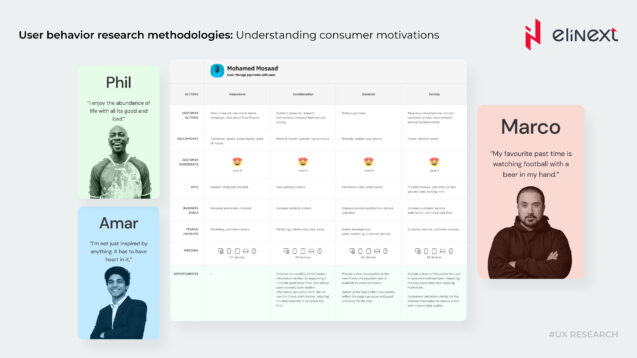
- Test and optimize the map. Once created, the map should be tested for effectiveness and its ability to identify possible shortcomings. Adjust the map as needed to achieve optimal results.
- Continuously update the map. Regularly update and adjust the map based on customer feedback, new data, and changes in the product or service. This ensures ongoing improvements to the user experience and increased customer satisfaction.
Benefits of Using Journey Mapping for Clients
Organizations that practice journey mapping offer clients numerous advantages. These include:
- Improved product or service quality, leading to increased customer satisfaction and loyalty.
- Personalized experiences that meet each customer’s needs.
- Consistent delivery of high-quality products and services, establishing trusted relationships.
- Efficient problem resolution that results in quicker response times.
- Timely and relevant communication about product updates and changes.
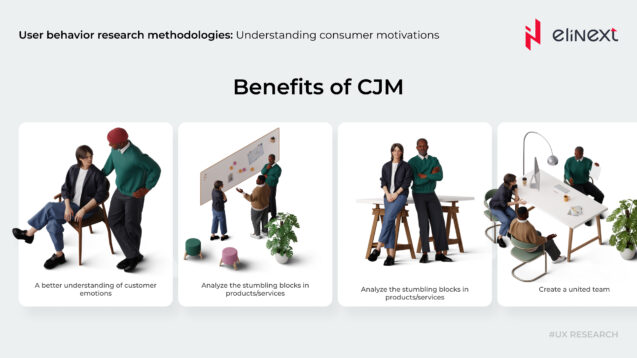
- Expanded product and service offerings that provide better value.
- More effective decision-making influenced by customer input.
- Enhanced trust and loyalty, nurturing long-term customer relationships.
On the business side, the benefits of journey mapping include:
- Increased customer satisfaction and loyalty, leading to revenue growth.
- Improved interdepartmental interaction, resulting in increased efficiency and employee skill enhancement.
- Cost reduction through process optimization and operation streamlining.
- Timely delivery of products and services to ensure customer satisfaction.
- Another positive aspect is the increase in successful deals that get closed, which can rise by 16%. This indicates that the sales process in the company has become more efficient, leading to an increase in the conversion rate and a reduction in sales cycles.
- Increase in employee engagement by 14%. This positive change indicates that employees are more engaged in their work, elevating overall company productivity and efficiency. Source: heartofthecustomer.com
Another study highlights how journey mapping can drive revenue growth, making it one of the most compelling benefits today. According to Forrester research, experience-focused companies achieved revenue growth 1.4 times faster, and their customer value increased 1.6 times compared to other companies. This suggests that consistently positive customer relationships can shorten sales cycles and boost revenue.
However, what exactly gives journey mapping these advantages? The value of journey mapping lies in its ability to provide the following benefits:
- Making intangible experiences visible and understanding the customer’s perspective. Journey mapping identifies pain points, key moments, and experience gaps, addressing low satisfaction and other KPIs. Focusing on optimizing customer interactions shifts us from internal processes to a customer-oriented approach, fostering team understanding and efficiency.
- One of the main advantages of customer journey mapping is the ability to gain a broader view of the business. By taking a step back, we can look at our organization or product from different perspectives, including those of customers, employees, and external stakeholders. This approach helps us understand the problem we are trying to solve by providing a holistic view of the situation.
Customer Journey Maps: A Reliable Way to Understand the Causes of Problems
Companies often identify problems through indicators or complaints. Analyzing these can reveal root causes, and customer journey maps are invaluable for pinpointing pain points in the customer experience.
Beyond problem identification, CJMs highlight opportunities for improvement and innovation, such as addressing service gaps to create seamless experiences. These maps can also uncover broader market opportunities, positioning companies to develop competitive, all-in-one solutions.
Customer Journey Analysis
Analyzing the customer journey provides insights into improving interactions and loyalty. This involves collecting data, creating customer profiles, and evaluating interactions. Benefits include identifying all customer touch points, understanding the journey from start to finish, assessing the impact on loyalty, and pinpointing areas of dissatisfaction. This analysis helps tailor marketing strategies to specific customer needs, enhancing overall service quality.
Communication Channels for CJM
Collecting feedback throughout the customer journey offers a comprehensive view of their experience. Various channels include:
- On-site: Capture feedback during visits (e.g., restaurant surveys).
- Email: Automatically send feedback requests post-purchase.
- Call Center: Collect feedback through follow-up surveys.
- In-App: Integrate surveys seamlessly into app usage.
- Website: Gather feedback from visitors and customers for continuous improvement.
An Example of Creating a Consumer Experience Map
Starbucks, for example, excels in personalized customer service, managing the overall experience from the moment a customer enters the store. Imagine your visit to Starbucks: you are greeted by the aroma of freshly roasted coffee and a barista’s warm smile. Quiet background music creates a peaceful atmosphere. When you receive your drink, you notice your name on the cup, showing their attention to detail. Regular customers are easily recognized, and their orders are quickly prepared.
The coffee giant offers more than just a product; it creates unforgettable experiences that foster customer loyalty. This strategy allows them to set premium prices much higher than their competitors. This demonstrates their commitment to high-quality customer service, which is central to their business strategy.
Below is a template for creating a customer journey map that may be useful to you and your team. If you want to download the template, please continue reading! Alternatively, you can scroll down the page.
To better understand and improve customer service quality, it’s essential to map out your customer journey, including actions, motivations, questions, and pain points along a timeline. Use surveys and interviews to gather insights into customer needs and preferences to enhance their experience.
Here’s how you can utilize customer journey data to improve service quality:
Understand Customer Interactions: Analyze each stage of the customer journey to identify customer interactions and actions. Note their emotions and experiences at each touchpoint.
Identify Gaps in Expectations: Compare customer expectations with their actual experiences to pinpoint areas where expectations are not being met, highlighting needed improvements.
Address Pain Points: Identify and resolve obstacles that hinder customer progress, such as process issues or pricing concerns, to improve overall satisfaction.
Focus on Key Touch Points: Prioritize improvements at touch points that consistently receive low ratings to significantly impact overall service quality.
Track Customer Satisfaction Metrics: Monitor customer satisfaction metrics at various stages of the journey to gauge the effectiveness of your efforts. Look for trends and patterns to identify areas of focus for ongoing enhancement.
Incorporating UX research into journey mapping provides insights into user needs, designs intuitive interfaces, and avoids costly mistakes, enhancing existing services and developing successful and sought-after products.
Wrapping Up
In conclusion, mapping out customer journeys offers numerous benefits, from increasing revenue for profit-driven organizations to serving as a valuable tool for nonprofit entities.
By leveraging UX research, you can develop products and services that better meet user needs, improve existing offerings, and ultimately, enhance customer satisfaction!









